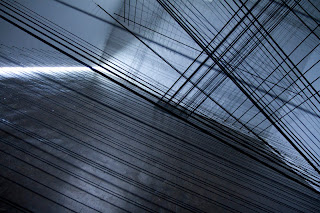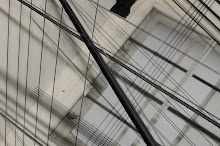IT IS A SPACE WHERE THE PERSPECTIVE FLATTENS AND FLATNESS IS ACQUIRING THE DEPTH AND VOLUME.
AND WHERE THE ACTION OF GOING OUT OF THE MULTIPLE WINDOWS IS AN ACT OF LIBERATION.
In a factory described by Foucault, there were.. tables... workers....and 88 windows... The structure of the space to make observation of each individual and all of them simultaneously possible. I took these 88 windows as a title and transplanted it into my installation. It is not exactly 88 windows, but they are loads, loads of them. How the intersection of all these windows creates the space is exactly what I am interested in. And then, in a human element penetration through each of them and each of the lines through each other.
A building on 8A Courtenay Street contains a double function of a duality: being a historical art collection on the ground floor and Bounce Back training ex-offenders new skills in painting and decorating on the first. Project Space is located in-between those two layers that have extremely fluid borders with each other. For me, this duality represents an important tension, contradiction and an overall beauty and charm of the place. It is a challenge of extreme power provoking your thoughts, associations and actions, as a consequence.
For Foucault, the structure of the prison is nearly equal to the structure of other social establishments such as schools, hospitals, factories... I would add here any kind of organizations and beliefs that explains the structure of the universe for you. In reverse, those influences you are entitled to fight with.
The
main restriction for the project was the condition of no drilling
inside the floor apart from the places where a natural decay occurred
and wooden tiles were taken off. This condition being perceived by me as a limitation
at the beginning, assured the structure of the whole installation that had happened to become a strictly site-specific process-based self-referential artwork.
10 JULY - 26 SEPTEMBER 2012
From
that side of the street the heavy storm of applause
are
reaching the ground, I open my eyes. At once, cannot find
the
perspective. Simultaneously everything is flat and round, far and
near
and does not have a name. Later, whirling, it is coming closer, stops
and
again takes the appearance that correlates to the normal titles.
When
all of it has already happened? And that has been already
like
that! Somehow I know it, but how I know, cannot
remember.
But
it is
precisely
these models
that,
before providing a solution,
themselves
pose a problem: the problem
of
their existence and the problem of their diffusion.
The
largest of the buildings, built in 1791, by Toussaint Barre,
was
110
metres long
and had three storeys. The ground floor was
devoted
mainly to block printing; it contained 132
tables
arranged in
two
rows, the length of the workshop, which had eighty-eight
windows;
each
printer worked at a table with his 'puller', who prepared and
spread
the colours. There were 264
persons.
At the end of each
table
was a sort of rack on which the material that had just
been
printed was left to dry (Saint-Maur). By walking up
and
down the central aisle of the workshop, it was
possible
to carry out a supervision that was
both
general and individual […] All
these
serializations
formed a
permanent
grid:
[…] related to the
individual
who was
its
particular
agent.
In
discipline,
the
elements are
interchangeable,
since each
is
defined by the place it occupies in a series,
and
by the gap that separates it from the others. The unit is,
therefore,
neither the territory (unit of domination), nor the place
(unit
of residence), but the rank:
the place one occupies in a classification,
the
point at which a line and a column intersect,
the
interval in a series of intervals
that one
may
traverse one after the other. Discipline is an art of rank, a
technique for the transformation
of
arrangements. It individualizes bodies by a location that does not
give them a fixed position, but distributes them and circulates them
in a network of relations.
Michel
Foucault. Discipline and Punish. The birth of the prison.






